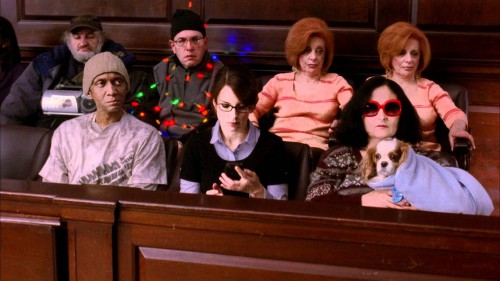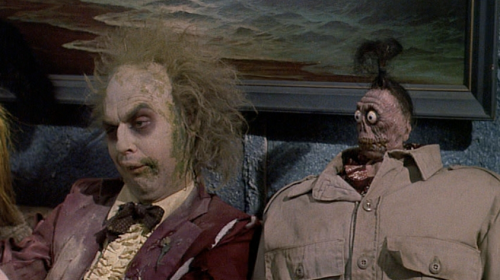
Last week, The New Yorker published a brief Daily Shout titled “I Let My Toddler Dress Me, And It Led To The Destruction Of Civilization.” In this frank address from wife to husband, she describes the calamitous results of her child’s wardrobe choices for her: first, she loses her job, then the government falls, and soon the world has spiraled into a lightless warzone steeped in anarchy. This chaos is all due, of course, to some “mismatched knee socks and a Santa hat” worn to work.
On Day One, “unfortunately, the fun idea of having your kids dress you had spread like wildfire, and within hours the judicial branch was gone. It was not long before the executive and legislative branches also fell.”
Day Two goes like this:
My little guy thought it would be fun for me to wear six belts over a pair of hot-pink leggings. So embarrassing. But also extremely dangerous in what was now a mostly lawless land. I had become the hunted, and bright pink made me an easy target.
When I left the house, I saw bitterly divided factions at war with one another. The words ‘The Rebellion Is Here’ were painted on the side of a building, and I was unsure whether or not they were drawn in blood. Before I could gather more intelligence, I was hit with a blow dart.
When I awoke many hours later, my son and I were back in our home, both unharmed. There was a note on the wall, held in place with a knife.
It read, ‘Do not again attempt escape. You belong to us now.’
With a heavy heart, I snapped a selfie of my outfit, and removed all of my belts.”
By Day Four, her “kid made [her] wear a blazer under a T-shirt! Also, They bombed the sun.”
 The catastrophe builds, and ultimately the world is destroyed. The piece is hilarious (and morose?), but it also begs a question with greater implications, playing as it does on certain everyday fears. What actually happens when we break the norm? And furthermore, why are one person’s choices enough to shake the foundation of civilization?
The catastrophe builds, and ultimately the world is destroyed. The piece is hilarious (and morose?), but it also begs a question with greater implications, playing as it does on certain everyday fears. What actually happens when we break the norm? And furthermore, why are one person’s choices enough to shake the foundation of civilization?
Dunlap’s story touches on a vein of thought that most of us are familiar with in one form or another: I, the individual, am the Star of the Show, Center Stage, a Truman-Show-esque nucleus of macro-level attention. My successes can—and will—singlehandedly keep the Earth spinning. My failures could cause it to shatter.
And so we mull over our questionable decisions, unusual inclinations, or random mistakes and wonder how the rest of the world perceives them/us. We essentially exist in our heads, after all; every interaction, every conversation, every step is perceived through the lens of just two eyes. This reality breeds an acute tendency for over-analysis. Isolated incidents become the seedlings for global distress verging on apocalypse.
For instance, you’re talking to Joe Schmoe. Joe says something, you miss it. “What?” Joe says it again. “What?” He repeats it a third time. Panic ensues. “I…er…yes!” you reply. You walk away from his inquisitive look and ruminate on the interaction for at least 5 minutes, thinking how awkward, how dumb you must have seemed. You tell your friends, laughing while wondering how far the scales have tipped against you in Joe’s favor. Meanwhile, Joe left the conversation thinking of his wife, their anniversary tomorrow, the flowers he has to get, the deadline he might miss, the light-bulbs he needs to replace. It’s not that you’re not important to Joe, but that small instance was but a fleeting moment. It would not, as Dunlap might joke, incite a Rebellion.
 On the other hand, there are also those of us who prefer to dwell in the missteps and awkwardness. We might revel in the discomfort of others, carouse in performing “micro-aggressions”, whether those are behavioral or physical or declarative. This lifestyle operates on that same fundamental assumption, however, the assumption that the Center Stage effect is “it” and the future survival of the Planet hinges on our decisions, the Stars. And central to these actions is the understanding that those around us will be judging.
On the other hand, there are also those of us who prefer to dwell in the missteps and awkwardness. We might revel in the discomfort of others, carouse in performing “micro-aggressions”, whether those are behavioral or physical or declarative. This lifestyle operates on that same fundamental assumption, however, the assumption that the Center Stage effect is “it” and the future survival of the Planet hinges on our decisions, the Stars. And central to these actions is the understanding that those around us will be judging.
The cause-and-effect, heightened sense of the nuclear self has been explored to no end. David Foster Wallace’s “This Is Water” sums up the notion much more thoroughly. This theme pervades throughout the brand new Technology issue as well; affirmation, even mere attention, motivates us to take stands and make statements. We opt to choose and publicly stand by those choices, because they garner a response. It’s easy to believe that our trajectory equates to “the world’s trajectory,” because what other path can an individual ever experience besides his or her own?
But consider: You do say the wrong thing. You ask “what” one too many times and Joe does find it odd. You make the wrong choice. You err, you fail. Big or small, these mistakes do have literal consequences and those consequences will, of course, vary. They might be unpleasant. However, the sky will not fall. Order will not collapse; infrastructure will not implode.
If my mistakes were suddenly incarnated as clothing ripe for a toddler’s giddy hands, I’m certain I’d be walking around in chain mail and pantaloons, wearing onions as earrings and skis for shoes. I’d be dressed in a lot worse than the rain boots, polka-dot dress, baseball cap and knit poncho that Cirocco Dunlap’s child forces her into. If I were turned inside out, my thoughts and judgments and faults would resemble something like Beetlejuice in a tiara with combat boots. In fact, I think we all might look something like the entourage in David Bowie’s “Ashes to Ashes” video.
Fortunately, Grace relieves us from the anxiety that accompanies this transparency, because while the tutus and stripes and sequins may seem like a disguise, a wardrobe reflecting our internal selves belongs on a very unrehearsed Center Stage. In this production, the Star is no longer self-constructed but revealed, and the Audience does not judge but takes us as we are. God already sees the pantaloons, the eye patches, the wizard hats, and the shoe bells incarnated out of our errors and our narcissism. He sees that “selfie snapped with a heavy heart,” and He forgives.
https://www.youtube.com/watch?v=CMThz7eQ6K0

COMMENTS
2 responses to “Inside-Out on Center Stage: The Wardrobe of a Sinner”
Leave a Reply















Love this!
Love how you describe our obsession with our own awkwardness.. great piece, Liz!